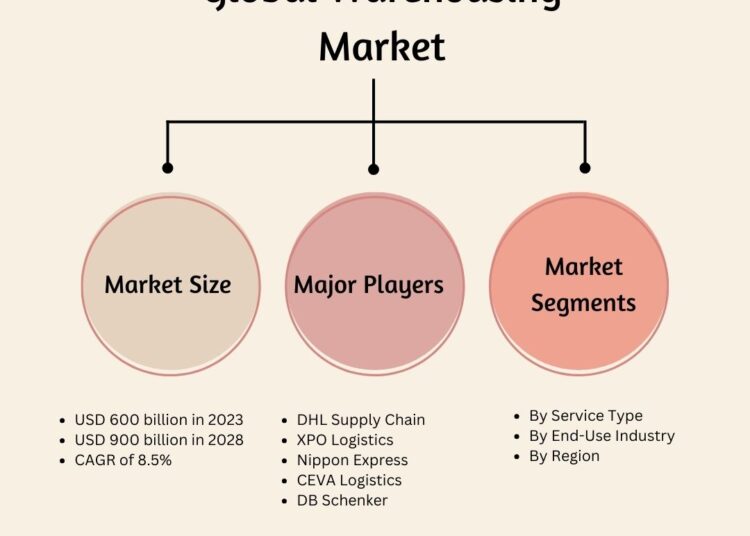Global Warehousing Market Overview
- The Global Warehousing Market was valued at USD 600 billion in 2023. The size of this market is expected to increase to USD 900 billion by the year 2028, growing at a Compounded Annual Growth Rate (CAGR) of 8.5%. Driven by the increasing demand for efficient storage solutions, global trade, and the rise of e-commerce, the market is witnessing significant growth.
- The Global Warehousing Market is dominated by several key players, including DHL Supply Chain, XPO Logistics, Nippon Express, and CEVA Logistics. These companies have established themselves as leaders through continuous innovation, extensive service portfolios, and strategic partnerships. Their strong presence in the market is also supported by their ability to provide comprehensive storage solutions tailored to specific customer needs.
- In 2022, XPO Logistics announced the acquisition of Clipper Logistics for $1.5 billion. This strategic move aims to enhance XPO’s capabilities, particularly in the warehousing segment. The acquisition is expected to accelerate the adoption of efficient storage solutions, improving inventory management and operational efficiency. This development underscores the increasing importance of warehousing in the global logistics industry.

Global Warehousing Market Segmentation
The Global Warehousing Market can be segmented based on several factors such as by service type, by end-use industry, and by region.
By Service Type
Market segmentation by service type is divided into general warehousing, refrigerated warehousing, and automated warehousing. In 2023, the general warehousing sub-segment leads the global warehousing market by service type, accounting for the largest value share. This is driven by the high demand for basic storage solutions across various industries.
By End-Use Industry
Market segmentation by end-use industry is divided into retail, manufacturing, food & beverage, and healthcare. In 2023, the retail sub-segment dominates the global warehousing market by end-use industry, holding the largest value share. This is due to the rapid growth of the e-commerce sector and the need for extensive storage facilities.
By Region
Market segmentation by region is divided into North America, Europe, Asia-Pacific (APAC), Latin America, and Middle East & Africa (MEA). In 2023, Asia-Pacific dominates the global warehousing market by region, capturing the largest value share. This is due to the region’s extensive manufacturing industry and high demand for efficient storage services.
Major Players
- DHL Supply Chain
- XPO Logistics
- Nippon Express
- CEVA Logistics
- DB Schenker
- Kuehne + Nagel
- GEODIS
- Ryder Supply Chain Solutions
- Expeditors International
Global Warehousing Market Growth Drivers
Rising Demand in E-commerce
The extensive use of warehousing services in the e-commerce industry is significantly driving the market. According to the International Warehousing Association (IWA), global e-commerce sales reached $7 trillion in 2023, with warehousing playing a critical role in storing and managing goods for consumers worldwide.
Expansion of Global Trade
The expansion of global trade, particularly in developing regions, is another major growth driver for the market. Warehousing services are essential for facilitating international trade and storing goods before distribution. According to the World Trade Organization (WTO), global trade is projected to grow by 4.5% annually from 2023 to 2028.
Technological Advancements
Continuous advancements in logistics technologies, such as the development of automated warehousing systems and advanced inventory management tools, are also propelling market growth. Companies are investing in research and development to improve operational efficiency and enhance customer satisfaction.
Global Warehousing Market Challenges
Environmental Concerns
The environmental impact of warehousing operations, including energy consumption and waste management, poses significant challenges for the market. Stringent regulations imposed by environmental agencies to reduce carbon footprints present a challenge for market growth. Companies are required to invest in green technologies and sustainable practices, increasing operational costs.
Fluctuating Real Estate Prices
The prices of real estate, which is a critical component of warehousing services, are subject to fluctuations, affecting the overall operational cost. These price variations can impact profit margins and pose a challenge for market players.
Global Warehousing Future Market Outlook
The market is expected to reach USD 900 billion by 2028, driven by continuous advancements in logistics technologies and increasing demand for warehousing services. The integration of environmentally friendly storage methods will further enhance operational efficiency and create new opportunities across various industries. Governments and organizations worldwide are prioritizing sustainable practices to meet regulatory standards and ensure market expansion.
Future Market Trends
Expansion of Sustainable Storage Methods
Sustainable storage methods, such as the use of renewable energy and eco-friendly materials for warehousing operations, will play a crucial role in the future of the market. These methods reduce environmental impact and enhance the overall efficiency of storage processes, supporting the growing demand for environmentally friendly solutions.
Enhanced Digitalization
As the market progresses, the need for enhanced digitalization will become paramount. Companies will invest heavily in advanced digital technologies to streamline warehousing operations, improve inventory management systems, and enhance customer experience. Innovations in digital solutions will shape the future of the market, addressing the growing challenges of efficiency and customer satisfaction.




